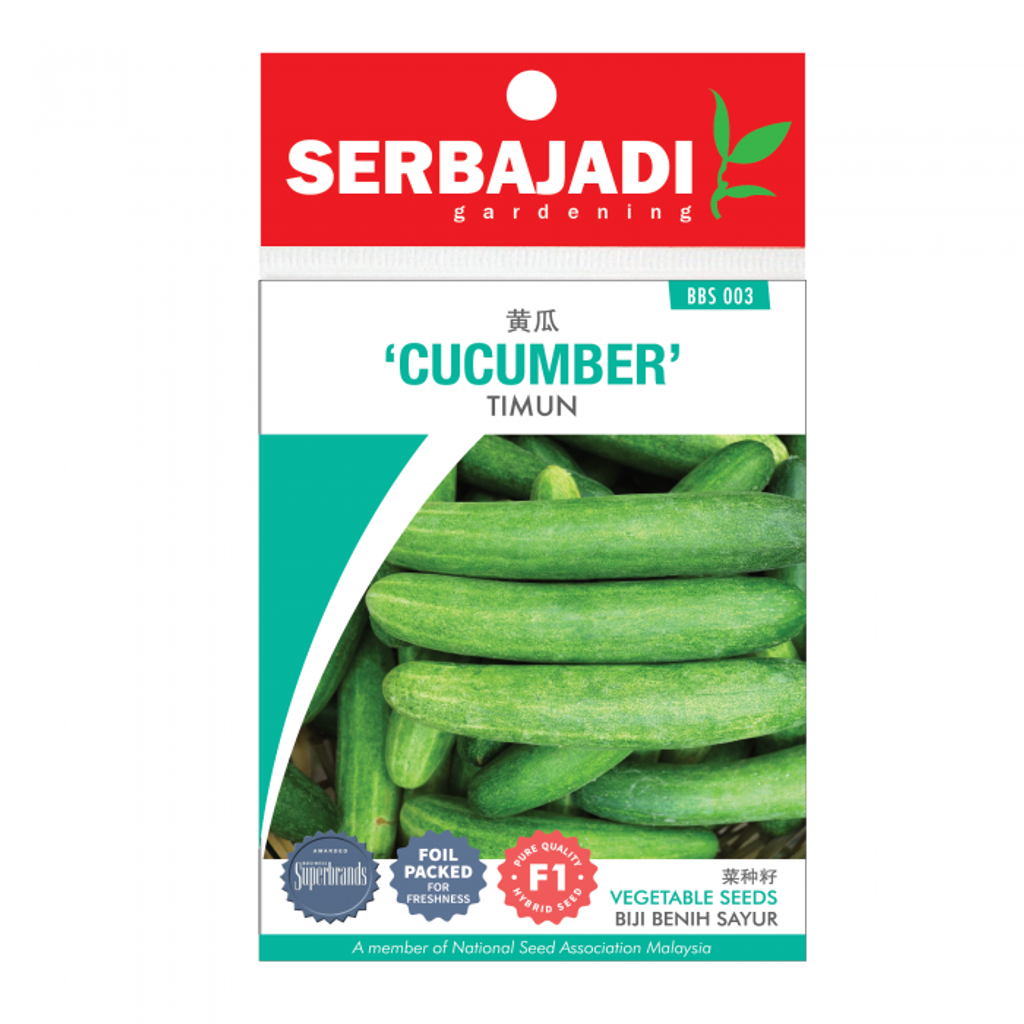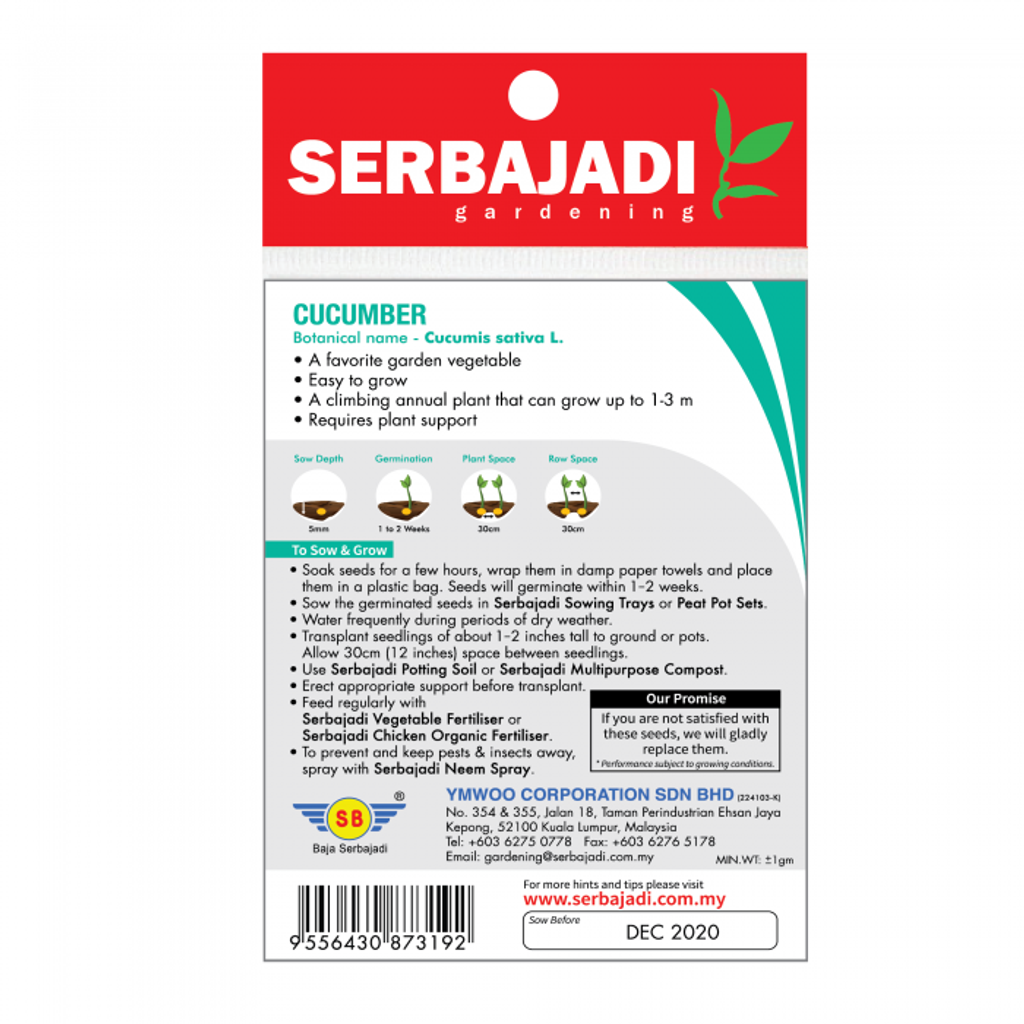Serbajadi Seeds F1 Hybrid Cucumber - Timun ( BBS003 ) (+/- 15 Seeds)
Serbajadi Cucumis sativa L. (Cucurbitaceae)
Cucumbers are members of the Cucurbita family which includes pumpkins, squash, and gourds. They are a favorite garden vegetable and they are easy to grow. The plant is a climbing or trailing annual herb that can grow up to 1-3 m, and the fruits are pendulous and variable in shape and size, with pale, green flesh and many seeds. Cucumbers contain most of the vitamins you need every day.They are high in magnesium, potassium, and vitamins A, C and K and contains 24% protein. Fresh unripe cucumbers are usually eaten raw as salad vegetables or made into pickles, they are great on vegetable trays with dip, sliced or in salads. The ripe fruits are popular for soups. Cucumber cleanses and beautifies the skin. Because of their high water content, the cucumbers are among the lowest calories vegetables. Nevertheless, it is rich in shin-protective ingredients.
Type of vegetable: Fleshy fruited
Edible parts: Fruits
DIRECTION OF USE
Best soil:Cucumbers grow best in moist but well-drained locations. They tolerate partial shade. A warm, sandy, humus-enriched neutral or slightly acid loam is ideal. Require a very rich soil with plenty of well-rotted manure and compost.
How to plant: Plant seeds in rows or hills 1 to 1 1/2 inches deep. When planting in rows, sow seeds 2 to 3" apart. If you are planting in hills, plant four to five per hill. After they have germinated, keep the best two to three. Cover very lightly with soil. Water the first day and if there is no rain, every two to three days until they germinate. Cucumber transplant badly, so seeds should be sown in situ 2cm deep at the side of a small mound. Plant a few seeds in a hole and later the seedlings can be thinned to one seedling after germination. Pot planting is also possible. Another method is to sow seeds indoors, in biodegrable pots to prevent root disturbance, and plant seedlings out after hardening off. Set up support at planting time.
When to harvest: 55 to 65 days. Cucumbers grow quickly and are at their best when picked before they get too big. Once cucumbers begin to ripen, you can usually harvest them for several weeks. Pick the first small fruit to encourage better production. It is important that the fruits are picked as soon as they are of edible size so that further fruits and flowers can be produced. Picking encourages continued production. Do not allow fruits to become large and seedy.
How to harvest: Fruit should be picked when young to avoid bitterness. Pick the fruits regularly to ensure a continuous crop and water plentifully and often.
Care: Train the climbing shoots and pinch out the apical shoot to encourage side shoots. When these shoots reach the top of the support, nip them out to have the laterals develop more fruits. They also need plenty of water and should never be allowed to dry out. Weed regularly. Like other members of the cucurbita family, they are big eaters. Provide plenty of fertilize high in nitrogen. Switch over to a more balanced fertiliser, after the flowers begin to bloom. A side dressing of fertilizer and regular feedings of fertiliser will significantly help the health of the plant and the size of the harvest. Also make sure to provide lots of water to for fast growth. Like all members of the Cucurbita family, the Cucumber Beetle is the dreaded pest of cucumbers. Cucumber Beetles are either striped or spotted. They feed on the leaves of the plants and can cause even greater damage as they spread disease from one plant to another. They are effectively treated with most insecticides. Mild insecticides like Sevin are most commonly used for effective treatment.
STORAGE
Keep away from children and pets.
Store in cool and dry place away from direct sunlight.


